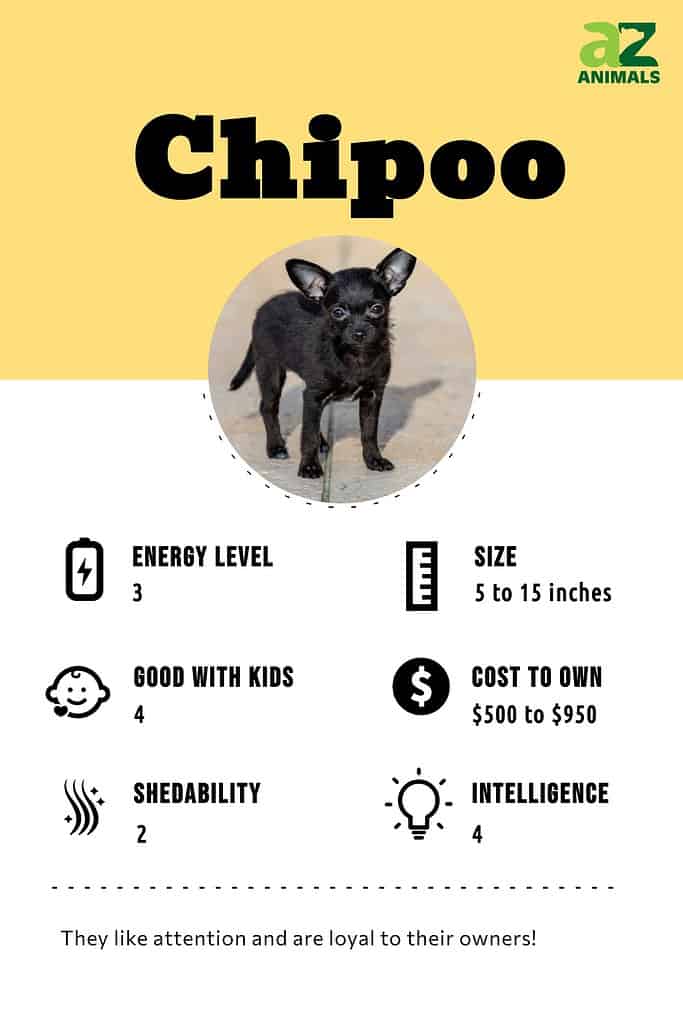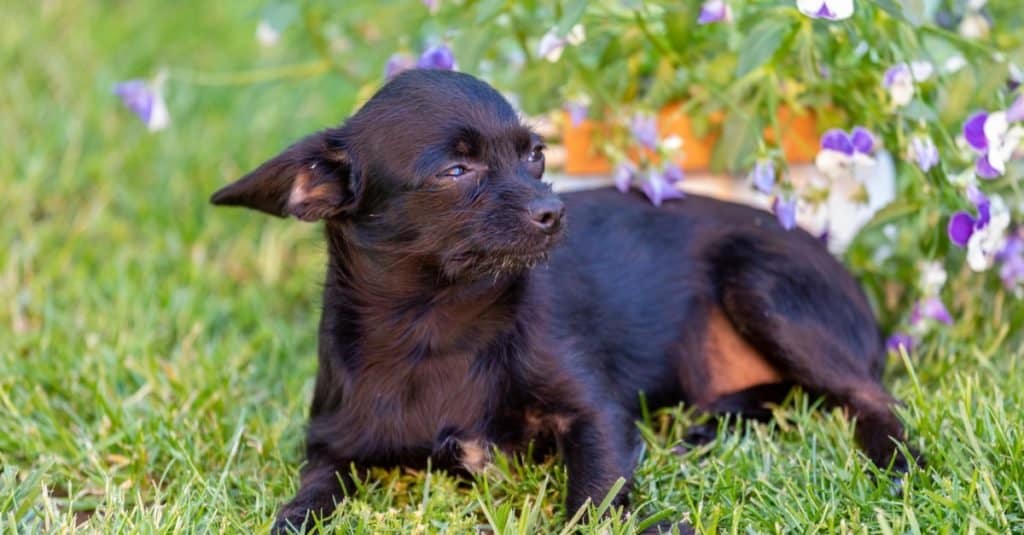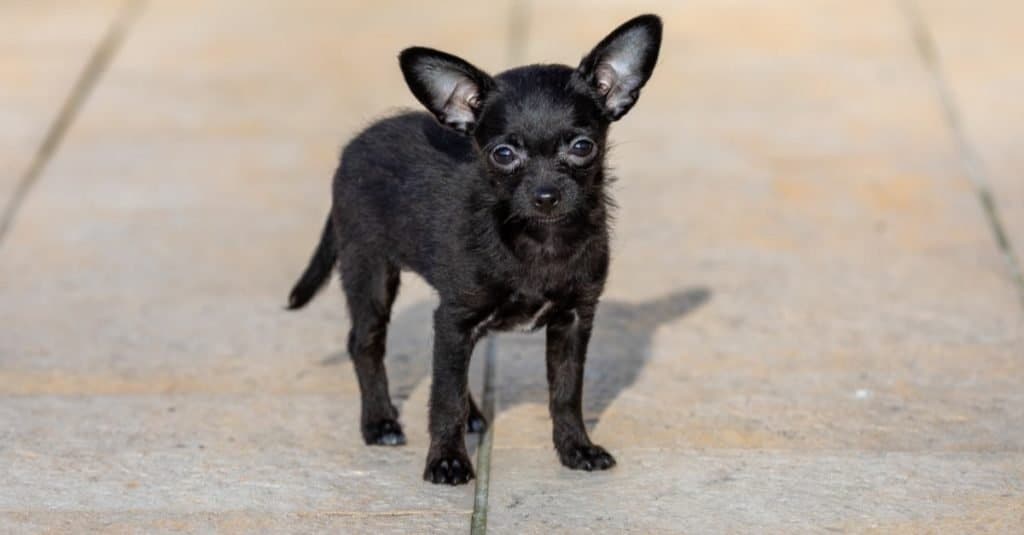Chipoo
Canis lupus
The Chipoo was first bred in the 1970s
Advertisement
Chipoo Scientific Classification
- Kingdom
- Animalia
- Phylum
- Chordata
- Class
- Mammalia
- Order
- Carnivora
- Family
- Canidae
- Genus
- Canis
- Scientific Name
- Canis lupus
Read our Complete Guide to Classification of Animals.
Chipoo Conservation Status
Chipoo Facts
Chipoo as a Pet:
- General Health
- Energy Level
- Shedability
- Trainability
- Intelligence
- Tendency to Chew
- Size
- Family and kid friendliness
- Yappiness / Barking
- Moderate
- Hypoallergenic
- Yes
- Separation Anxiety
- Moderate
- Preferred Temperature
- Average climate
- Exercise Needs
- Moderate
- Friendly With Other Dogs
- Moderate
- Pure bred cost to own
- $500 or more on average
- Dog group
- Toy
- Male weight
- 3-20 lbs
- Female weight
- 3-20 lbs
This post may contain affiliate links to our partners like Chewy, Amazon, and others. Purchasing through these helps us further the A-Z Animals mission to educate about the world's species.
View all of the Chipoo images!
The Chipoo was probably first bred in the 1970s, when the idea of a designer Poodle became popular.
The Chipoo is a cross between a purebred Chihuahua and a purebred Poodle. The common term for this is a designer dog, in which two purebreds are crossed to produce desirable traits from both. The Chihuahua, which originated from Mexico, is a small, short-haired dog with a big, charming personality. The Poodle, which originated from Germany, is a small, long-haired dog with keen intelligence and athleticism. When crossed together, these two dogs can produce puppies with a wide variety of different characteristics. But owners can usually expect a Chipoo to have smooth, curly, or coarse hair of varying lengths with a brown, blue, black, white, cream, fawn, or silvery grey color.
See all of our expert product reviews.
You may have heard this breed being referred to by some really cute names like Chipoodle, and Poochi! Some other fun names are Choodle and Poohuahua. These designer dog names are usually very interesting!

3 Pros And Cons Of Owning A Chipoo
| Pros! | Cons! |
|---|---|
| Loyal and Affectionate The Chipoo forms a deep and loving bond with its owner. | Fragile Because of its particularly small and fragile body, the Chipoo needs to be handled with extreme care. |
| Light Shedding The Chipoo is a particularly good choice for people who don’t want or cannot tolerate a heavy-shedding dog. | Food Sensitivities The Chipoo has some digestive problems that make it sensitive to certain generic foods. |
| Adaptable This mix does well in a variety of different living situations. | Separation Anxiety If given a good play area, the Chipoo can actually entertain itself, but don’t leave it alone for too many hours, or else it may turn into destructive or unwanted behavior. |

The Chipoo can entertain itself but shouldn’t be left alone for too long.
©Jane Rowden/Shutterstock.com
History Of The Breed
The Chipoo is thought to have originated in the United States in the 1970s and while there isn’t much more known about their history, they come from two breeds that have been around for quite some time – the Poodle and the Chihuahua. The poodle originated in Germany in the middle ages, even though it is the national dog of France, and was intended as a hunting dog. The chihuahua is believed to have come from Mexico and has been around since the 9th century. Thought to have been derived from the Techichi dog, which was a small mute animal that the Mexican Toltec people held.
Size And Weight
Just like its parents, a full-grown Chipoo is a small-sized dog with a thin frame. Some individuals are so small that they can quite literally fit inside a teacup. These so-called teacup dogs are fairly common among the Chihuahuas and Poodles as well. A teacup Poodle is more likely to produce a teacup Chipoo. There are also a few differences in the size and appearance of the males and females.
Health and Entertainment for your Chipoo
See all of our expert product reviews.
| Height (Male) | 5 to 15 inches |
| Height (Female) | 5 to 15 inches |
| Weight (Male) | 3 to 20 pounds |
| Weight (Female) | 3 to 20 pounds |
Common Health Issues

The Chipoo may inherit some health issues from either parent breed but a healthy dog can live a long life of about 12 to 15 years.
©Vincent Scherer/Shutterstock.com
As a designer dog, the Chipoo may inherit some health issues from either parent, but it’s difficult to know ahead of time which ones these will be. In general, the most common problems are cancer, dry skin, digestive issues, hypoglycemia (low blood sugar), luxating patellas (essentially, a loose knee cap), and some eye conditions (particularly glaucoma, which can lead to blindness). If the Chipoo can avoid some of the worst health problems, then it can live a relatively long life of about 12 to 15 years. To sum up some of the most common health problems:
- Cancer
- Digestive Sensitivities
- Hypoglycemia
- Dry Skin
- Luxating Patellas
Temperament
The Chipoo is an intelligent, energetic, and fun-loving dog with a big, expressive personality. Since it will always want to be an essential part of the family, the Chipoo makes for a great companion and friend with a very loyal streak. Another appealing trait is that the Chipoo can adapt to a variety of different living situations and doesn’t necessarily need a big yard or open space to thrive, though ideally, it should have plenty of things to do and new challenges to overcome. If the Chipoo doesn’t get enough physical and mental stimulation, then it may turn to destructive or annoying behavior such as howling and chewing.
How to Take Care of the Chipoo
The Chipoo is a low to medium-maintenance dog with some specific dietary and grooming requirements that will need your attention. If you purchase this dog as a puppy, it is a good idea to take it to the vet for an early health screening and then continue to visit the vet at least once a year after that as a full-grown adult.
The Best Dog Food For Chipoos
Since it’s prone to some digestive problems, the Chipoo does best with high-quality food specially formulated for small dogs. Ideally, the food should be divided into several smaller meals throughout the day to maintain a consistent blood sugar level. Calorie intake and food composition will probably vary with the dog’s age, size, activity level, and health. A full-grown adult Chipoo will need to be carefully monitored for any signs of weight gain. At an ideal weight, you should be able to feel but not see the dog’s ribs. But a growing juvenile Chipoo dog can be allowed to eat as much as it wants for the first several months of life. If you need some help coming up with ideas for the dog’s diet, then you should consult with your veterinarian.
Since Chipoos can get hypoglycemia, try to be consistent about feeding your Chipoo a solid meal ninety minutes or more before exercise, because it needs adequate blood sugar to sustain the activity. Also, due to Chipoos’ stomach sensitivities, try dog food designed to be easily digestible.
A-Z Animals recommends Hill’s Science Diet Dry Dog Food, Adult, Sensitive Stomach & Skin Recipes.
The prebiotic fiber content aids comfortable digestion, plus zinc and Vitamin E soothe the Chipoo’s dry skin. Other nutrients like thiamine, riboflavin, taurine, calcium, biotin, and Vitamin B12 contribute to overall well-being.
Check Chewy or Amazon for this product.
- Prebiotic fiber nourishes your dog's microbiome for digestive health
- Smaller kibble is packed with nutrients like vitamin E and omega-6 fatty acids for optimal skin and coat health
- Formulated specifically for small and toy dogs
- Highly digestible ingredients
- This veterinarian-recommended recipe is made in the USA
Maintenance And Grooming
The Chipoo does not shed very much at all (which makes it a good choice for people with allergies), but depending on the length and the consistency of the coat, it still needs to be brushed at least two or three times a week and sometimes as often as every single day. In addition, the fur will need to be trimmed several times a year to prevent it from tangling. If you don’t want to do it yourself, then you can take it to a grooming professional, who can even give your dog a unique hairstyle. The dog will also need its ears cleaned and nails trimmed whenever necessary, and its teeth should be brushed daily to maintain good oral hygiene.
Training

You should train your Chipoo early to prevent it from exhibiting possessive behavior and house training problems.
©Vincent Scherer/Shutterstock.com
The Chipoo needs to be trained as early as possible in its life to prevent it from exhibiting possessive behavior, house training problems, and other undesirable behavioral issues. Fortunately, this mix is bright and intelligent and takes very well to training. Although it has a bit of a stubborn streak, the owner should remain calm and patient at all times. The Chipoo responds best to positive reinforcement methods such as food and encouragement. Do not raise your voice or make threatening gestures toward it, since that will just discourage your dog. It’s also a good idea to vary the training routine to prevent it from becoming bored. If you don’t have the time or inclination to train the dog yourself, then you can enroll your dog in a professional training program.
Exercise
Although the Chipoo has a lot of pent-up energy, it doesn’t take much exercise to get this does tire out. This highly adaptable dog enjoys all kinds of activities, including leashed walks, games, tricks, and playtime. These activities should be done in short intervals of about 10 to 30 minutes at a time.
Puppies

The Chipoo has a lot of energy but gets tired easily.
©Vincent Scherer/Shutterstock.com
Like just about any type of dog, it is always recommended to buy your puppies from a reputable breeder who screens for early health problems. Unfortunately, there are no rescue groups dedicated specifically for the Chipoo, but you may be able to find one at a Chihuahua or Poodle breed-specific rescue program that also cares for mixes. Regular rescue shelters are less likely to have one.
Chipoos And Children
The Chipoo is friendly and gentle around children of all ages. However, since the Chipoo is very fragile and sensitive, you should be careful about introducing this dog to smaller children. Always closely supervise any interactions between them. This is done as much to protect the dog from a child who may not understand how to handle one.
Dogs Similar To The Chipoos
If you are a fan of the Chipoo, then you should definitely check out its two parent breeds, the Chihuahua and the Poodle. There are several other types of dogs with obvious similarities. Here is a list of them:
- Labradoodle – Bred from a mixture of the Labrador and the Poodle, the Labradoodle is one of the most popular designer dogs in the world. Sporting a long, shaggy, hypoallergenic coat, it is kind, loving, obedient, and playful. The Labradoodle also responds very well to training. It’s been used as a service dog, a therapy dog, and a general companion.
- Cockapoo – Originally bred in the 1960s, this designer dog is a mix between a Cocker Spaniel and a Poodle. It has many appealing qualities, including keen intelligence, a big and affectionate personality, and a relatively good hypoallergenic coat that doesn’t shed a lot.
- Yorkshire Terrier – Bred in northern England as a vermin hunter, the Yorkshire terrier is a small, energetic breed with a long silky coat of elegant hair that should be okay for people with allergies. It is loyal, affectionate, brave, and protective of its owner. In fact, the rather bossy personality far outstrips its small size.
Famous Chipoos
The Chipoo is a relatively young and obscure type of dog. It has not yet had a major impact on popular culture. However, both the parent breeds, the Chihuahua and the Poodle, are among the most popular breeds in the United States. Both types of breeds have won dog shows and appeared in movies and TV shows.
Popular Names For The Chipoos
If you are looking for a good dog name, then you might want to consider one of these popular names for the Chihuahua and Poodle.
- Bella
- Coco
- Lola
- Daisy
- Peanut
- Charlie
- Max
- Buddy
- Teddy
- Lucy
Chipoo FAQs (Frequently Asked Questions)
What is a Chipoo?
A Chipoo is a cross between a purebred Chihuahua and a purebred Poodle. However, you should not expect the Chipoo to have an equal distribution of its parent’s traits. Even within the same litter, some puppies may be more like a Poodle, while others may be more like the Chihuahua. It’s difficult to predict what it will be ahead of time.
How do you potty train a Chipoo?
House training is always one of the more difficult challenges in a dog’s life, but there are several things you can do to make it easier for yourself. First, choose a specific area in your home where the dog can go regularly. Second, take your dog outside at predictable times, like shortly after a meal, and wait patiently until it goes. Third, you can encourage the dog to go by teaching it a key phrase and repeating it. That will allow the dog to know what is expected of it. Fourth, you should always use positive reinforcement methods without raising your voice. Reward its behavior with small, tasty treats or toys.
How big do Chipoo dogs get?
The Chipoo rarely grows larger than 15 inches at shoulder height and about 20 pounds in weight.
Are Chipoos hypoallergenic?
Although the Chipoo does shed a little, the relatively hypoallergenic coat still makes it a good choice for people with allergies.
How long does a Chipoo live?
The Chipoo has a life expectancy of around 12 to 15 years.
Are Chipoos aggressive?
No, the Chipoo is a very kind and gentle dog unless specifically threatened or provoked. But it does have the tendency to howl and bark a little.
Thank you for reading! Have some feedback for us? Contact the AZ Animals editorial team.
Sources
- Pet Guide, Available here: https://www.petguide.com/breeds/dog/chipoo/
- Poodle Mix Club, Available here: https://poodlemixclub.com/chipoo/


















